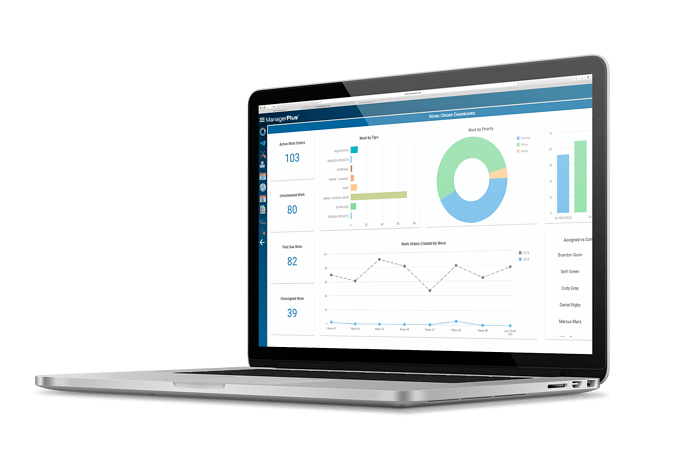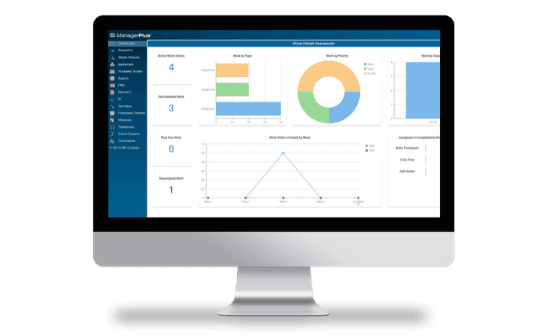As a facilities manager, you have a ton to track, including everything from the preventive maintenance program to MRO inventory, on-demand work orders to labor costs. But tracking numbers isn’t enough. To understand your operations, where you’re being cost effective day to day and delivering value to the overall organization long term, you need a reliable, repeatable way to measure success. Key performance indicators (KPIs) help you turn raw data into business insights you can leverage for efficient facility and maintenance management.
Let’s look at six KPIs that help you take control of maintenance with better visibility and stronger accountability. But first, we need to clear up any possible confusion when it comes to the definition of maintenance KPIs.
What is the definition of a maintenance KPI?
Key performance indicators are how facility management and maintenance management professionals measure how close they are to achieving their business goals. Every industry uses different sets of KPIs to track progress and performance, and facility management is no different.
What are the differences between a maintenance metric vs. a maintenance KPI?
While these terms are often used interchangeably, they aren’t exactly the same thing.
The best way to think of a metric is that it’s one single point of data that tells you something important, but it doesn’t define an objective or a goal. For example, total maintenance hours per week would be a metric while the ratio of preventive maintenance to reactive maintenance would be a KPI. It gives you a higher-level view of your operations because it’s a number that relates to a specific business goal.
KPIs are like a road map that shows where you’re veering off course and what paths you can take to get back on track. Again, a lot of people use maintenance metric and maintenance KPI to mean that same thing, but they’re not. And understanding the differences helps ensure you’re using them correctly when it comes to proper performance tracking.
Why should I track maintenance KPIs?
As a facility manager, you have goals and objectives you’re required to meet as part of your job. KPIs tell you how close you are to reaching those goals and where you need to improve. They also show you how well your building is performing. If your performance doesn’t match up with the larger business goals, then your KPIs can show your where the gaps are.
For example, if your reactive maintenance percentage is unusually high, then you may need to rethink your maintenance strategy by investing in a good facility management software solution. Maintenance KPIs give you the insights you need to set clear, achievable goals for your maintenance team.
What are the facility management KPIs?
There are six main KPIs for facility maintenance management.
- Reactive vs. planned maintenance
- Work order backlog
- Budget
- Preventive maintenance compliance
- Average time to completion
- Reactive response time
Depending on your situation and facility, the order of importance can change.

Reactive vs. preventive maintenance
You already know that preventive maintenance is significantly more cost effective than reactive maintenance, which is why it’s important to know what percentage of your total maintenance your team is completing reactively as opposed to preventively. Basically, are you taking the harder, more expensive way or the easier, less expensive option?
Once you know what proportion of your facility maintenance work is reactive, you can set concrete, achievable preventive maintenance goals, helping you save yourself time, money, and frustration over time. The reactive maintenance vs preventive maintenance KPI helps you identify patterns so you can see what types of work orders the team tends to tackle.
A robust facility management software solution can help you keep on the right side of the ratio. Because there are higher costs associated with reactive maintenance, a good rule of thumb is that less than a quarter of all maintenance tasks should be reactive.
Work order backlog
Once you’ve implemented a good preventive maintenance program, your maintenance team can begin to get a better handle on your building’s maintenance backlog. Every facility and every organization has a backlog of work orders, but that’s not necessarily a bad thing.
There’s a common misconception in the maintenance world that any backlog is bad. It really depends on how you look at it. If you define your backlog as all the work that’s gone past the date it’s due, then yes, backlog is bad. However, if your backlog is simply a list of approved but not-yet-completed work, then your backlog is defined by the priority of the work.
Every good maintenance manager prioritizes critical work over non-critical work, so that doesn’t always mean that the non-critical work becomes “past due.” Instead, it simply means you’re shuffling the work farther down the list.
Another way to look at it is if you don’t have any backlog, you might be overstaffed. If your team can too easily keep up with all the PMs and on-demand work orders, you might have more resources than you need.
On the other hand, if your backlog keeps growing, then you may not have enough technicians, or you might need to do some training to improve efficiency. As the backlog continues to grow, eventually critical work gets missed and things begin to slip through the cracks.
You can also look at your backlog from the departmental level and the asset level. One would be for all the maintenance work that needs to be completed across your entire team, and the second would be all the work that needs to be done for a specific asset.
The important thing here is to look at the asset’s criticality to help you determine an acceptable backlog size. If the asset is critical for your production lines, for example, this backlog might take priority and the goal would be to keep it as low as possible. If it’s a less critical asset, you could let the backlog grow a little and not be adversely affected.
The most important thing about your backlog is not the size but the rate and direction at which it changes. The worst situation to be in is to have a backlog that continues to grow uncontrollably. You’ll want to do everything you can to make keep your backlog stable and predictable.
A good target to shoot for is to have your non-critical backlog at between four to six weeks. Adopting a good work order software that helps you keep track of all your work orders can show you gaps in your maintenance operations and help you get your backlog under control.
Budget
One of the biggest responsibilities for any FM is managing budgets. You not only have to make sure you’re staying within your budget, but you also must ensure the right teams and resources get enough funding, all while reporting costs accurately.
You need to keep a detailed account of your costs so you can see where you can stretch your budget the farthest and where it makes sense to invest in or cut resources. The best way to do that is with facility management software that can give you detailed reports on exactly where all your money is going.
 By tracking things like work orders, parts and inventory, vehicle maintenance, and vendor work orders, you can get a detailed look into exactly where the money’s going and where you can make improvements.
By tracking things like work orders, parts and inventory, vehicle maintenance, and vendor work orders, you can get a detailed look into exactly where the money’s going and where you can make improvements.
Preventive maintenance compliance
Preventive maintenance is preferable to reactive maintenance, but there’s more to it than just scheduling inspections and tasks. The preventive maintenance compliance KPI is important because it helps you establish acceptable timeframes for when work should be completed, helping you not only gauge how well your organization is doing at completing work orders but also how many of them are completed on time.
You want to aim for as high a compliance rate as possible with a target goal of 100%.
Average time to completion
This one is pretty straightforward: how long does it take for work orders to get completed? With this KPI, you can identify inefficiencies in your maintenance operations and where you can make improvements. Is one particular asset taking longer to repair than the others? Maybe it’s time to consult the manufacturer or reach out to a contractor. Do you have a technician who is falling behind on completion times? They might benefit from some extra training.
Minimizing average time to completion helps ensure facility management assignments are completed in a timely manner and can work as a benchmark for how long it takes different tasks to be closed out.
Reactive response time
This maintenance KPI helps you track how quickly your maintenance team responds to mission-critical work orders. The goal is to show you the time it takes the team to close out a high- priority request.
Tracking response time is important not only for providing good customer service, but also because it can reduce both equipment and employee downtime. If a high-value asset is just sitting around waiting to be repaired, you’ve also got a team of operators in the same position, still on the clock.
Having a clear understanding of how long it takes to finish different kinds of assignments can prevent cascade failures where certain repairs must be done within a specific time frame or risk consequent breakdowns.
How can I improve my facility maintenance KPIs?
As a facility manager, it’s important to know what your KPIs are and how to improve them. KPIs help you evaluate how your team is currently and to give you a road map to improvement.
If you discover you’re spending much more time on reactive maintenance than preventive, how can you close the gap and move toward a proactive maintenance strategy? The best way is to use asset management software to track data on your equipment and tell you when it’s time to repair an asset before it breaks. Ideally, you could setup up work orders to automatically generate and be assigned to the correct technician, with all the correct parts and information necessary, without you having to do a thing.
Maybe your response time to critical maintenance requests is much longer than it should be. If you’re relying on paper or spreadsheet work orders, there’s not much you can do to improve the time it takes for requests to make it to your office, for you write them out, find the right technician, and to get the work started. With FM software, you can receive a request, generate a work order with all the relevant parts and information included, and get the right technician on the job in a matter of minutes.
What do you need to get started setting up KPIs for maintenance?
Every technician knows that you can’t do the job right without the proper tools. Sure, with enough force you could hammer in a screw, but it won’t give you the best results. The same applies to optimizing your maintenance operations.
Once you know where your gaps are, you need to use the correct tools to plug them, or you’ll just end up back where you started. Good facility management software is the best place to start.
Summary
Key performance indicators (KPIs) are the roadmap that shows you gaps in your facility management operations, and how you can get where you need to go.
The six main KPIs you should be tracking are:
- Reactive vs. planned maintenance
- Work order backlog
- Budget
- Preventive maintenance compliance
- Average time to completion
- Reactive response time
Once you’ve begun measuring your KPIs, you can plan out a path to improving them. But you need to use the right tools. ManagerPlus Lightning facility management software can help you optimize your operations by tracking important metrics like work orders and maintenance costs and show you areas to focus on.

